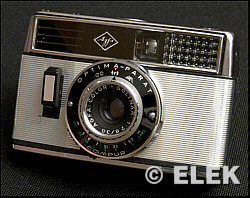Agfa Optima-Parat

|
|
|
| Style, film format | 35mm half-frame zone focus, autoexposure |
|
|
|
| Lens, shutter | Coated f/2.8 30mm Solinar, Compur shutter |
|
|
|
| Photo quality | Very nice |
|
|
|
| Ergonomics | Wonderfully cute, but take care with the front-mounted shutter release. |
|
|
|
This little Agfa arrived in 1963, right around the time that half-frame photography underwent a resurgence of sorts.
Half-frame photography had been around for decades, and in the 1960s, a new wave of cameras appeared on the market. Among the greatest was the Olympus Pen FT single-lens reflex system.
However, the Germans weren't sitting on their hands at this time. Agfa offered up three half-frames, according to several Internet sites. This one, the Optima-Parat, apparently was the premium model.
The Optima-Parat featured autoexposure (a novel feature in the 1960s), a Solinar lens, Compur shutter and a sleek body. It was a winning package.
I was pleasantly surprised when the camera arrived. I was expecting something along the lines of the other inexpensive Agfa Optimas. You know the ones -- they sell on eBay frequently for about $10.
The Optima-Parat is an intelligently -- and solidly -- built camera with some heft to it. As I mentioned, it's quite unlike some of the other Agfa Optimas you'll see on the market these days.
Well, let's get to work and see what it has to offer.
The Optima-Parat came with an ever-ready case that had seen better days. However, it cleaned up sort of nicely. The top fastens to the bottom via a triangular clip and can be removed, leaving you with a very nice half case that protects the camera and gives large-handed photographers a bit more to grasp.
The autoexposure is a "trap needle" system. Here's how it works: The selenium cell causes a needle to sweep across a predefined area. The needle sits between two metal jaws. The movement of the needle indicates different programmed shutter and aperture combinations. When the photographer presses the shutter release, it closes the jaws and locks the exposure setting. It's pretty cool and works well in most situations. If you think of the shutter release as an exposure lock, you can deal with backlit situations.
The manual doesn't state an EV range, and the shutter lacks slow speeds, which is just as well, given that the front-mounted shutter release is a bit stiff. I recall reading that the Compur shutter offered speeds from 1/30 to 1/250. The manual doesn't state any technical specifications.
Ironically, the all-manual exposure version -- the Paramat -- is usually seen with the Apotar lens -- a triplet that is considered to be a step down from the Solinar (four-element Tessar type).
Now, here's the bad news: If the selenium cell is dead, your camera is little more than a paperweight. This is a case where simpler is better and one in which the lower-priced model that lacked a meter will be the one still working at the end of the day. Luckily, the cell on my Optima-Parat seems quite lively.
The camera allows two all-manual speeds: Flash synch (appears to be about 1/30) and B. When set to either of these speeds, you have full control over the aperture.
The Optima-Parat lacks a rangefinder, although this shouldn't prove to be a problem. There are three pictograms (mountain, group portrait and portrait) above the lens and distance markers in meters and feet below the lens. And keep in mind that the lens is 30mm, which should help compensate for minor focusing errors.
One nice little surprise with this camera is the honest-to-goodness hotshoe. This was a bit of a surprise, because I was expecting the usual accessory shoe and flash-synchronization post. To be honest, I haven't shot more than a dozen photos with flash in the past four years. But if I want to ...
